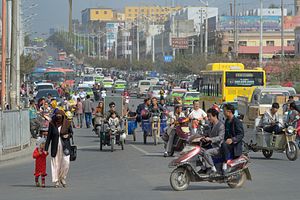Last week’s APEC summit in Beijing served as a major coming-out party for President Xi Jinping’s “one belt, one road” plan: the Silk Road Economic Belt and the Maritime Silk Road. Kerry Brown ably explored the historical and diplomatic meaning of the initiative in a piece for China Power. However, it’s also worth looking in more detail at the domestic ramifications of the Silk Road plan, and particularly its meaning for China’s troubled western regions.
The Xinjiang Uyghur Autonomous Region (XUAR) emerged as a major trouble spot domestically for China following violent riots and terrorist attacks within Xinjiang and as far away as Kunming and Beijing. Faced with this unrest, Beijing implemented a two-pronged strategy. First, the central government unleashed a severe crackdown on terrorist activities, resulting in mass arrests and trials. Second, Beijing doubled down on its previous strategy of promoting economic development in the region as a way of addressing ethnic tensions. The central government recognizes that unemployment and poverty among Uyghurs is a major driver of discontent.
In this context, the Silk Road initiative dovetails perfectly with China’s bid to develop its relatively poorer, underdeveloped central and western regions – including Xinjiang. The Silk Road Economic Belt provides a rationale for the central government to lavish spending on these inland regions. A report from Bloomberg says the government plans to set aside $16.3 billion for domestic infrastructure spending in support of the Silk Road. All of this money will be spent within China’s borders.
The effects of the Silk Road are already being felt in Xinjiang. Just this week, China opened the first leg of a new high-speed railway that will eventually connect Urumqi, Xinjiang’s capital, with Lanzhou, the capital of neighboring Gansu province. And it’s not only Xinjiang’s infrastructure that is garnering government-encouraged investment: Beijing and the provincial government have an ambitious plan to boost Xinjiang’s manufacturing, tourism, and even financial services industries, all as a part of Xinjiang’s new role as the gateway between China and Central Asia on the new Silk Road.
The newly-established city of Horgos is a case in point. Previously a small town of 85,000 on the border between China and Kazakhstan, Horgos has been targeted as a future transportation and commercial hub on the Silk Road. Already, trains filled with cargo are leaving from Horgos bound for Kazakhstan, Russia, and even Germany. In addition, Horgos is now home to China’s first-ever trans-border free trade development zone, with the zone encompassing both sides of the China-Kazakhstan border. The deputy director of the Horgos free-trade zone told the Wall Street Journal that more than 20 billion RMB ($3.25 billion) has already been invested in the Chinese side of the zone.
The impact on Horgos itself has been immense. Between January and August of 2014, Horgos’ government revenue was almost 80 percent higher than during the same period in 2013. That jump is almost entirely due to Horgos’ position as a “land port” for the Silk Road Economic Belt. The government’s hope is that this investment and employment boom will extend to other cities in Xinjiang.
However, Uyghur activists remain unconvinced that general economic investment is the answer to Xinjiang’s troubles. Alim Seytoff, spokesman for the World Uyghur Congress, told Al Jazeera that “Chinese investment has not brought so-called prosperity, stability or peace for the indigenous Uyghur people in East Turkestan.” In fact, he argued that increased strategic emphasis on Xinjiang has only brought more repression for native Uyghurs. Thus, Seytoff predicts that the recently revealed plan for a $40 billion Silk Road Fund “is really bad news for the Uyghur people.”
Xinjiang’s importance to the Silk Road concept is easily apparent just by glancing at a map. The XUAR borders Mongolia, Russia, Kazakhstan, Kyrgyzstan, Tajikistan, Afghanistan, Pakistan and India. China’s connections with Central Asia in particular will necessarily flow through Xinjiang, giving the province a crucial geopolitical importance for China.
However, the importance of the Silk Road to Xinjiang (or, more accurately, to Beijing’s plans for Xinjiang) is equally noteworthy. China’s eastern coastal regions grew wealthy and developed rapidly thanks to their position as a gateway between China and the world. Under its “March West” policy, Beijing is placing more emphasis on the world beyond China’s western borders, in the hopes that doing so will help replicate eastern growth in China’s landlocked central regions. That’s a particularly important goal when it comes to Xinjiang, as Beijing feels increased general prosperity will go a long way toward solving China’s growing terrorism problem. The trick will be ensuring that the massive amounts of investment in Xinjiang actually help better the lives of current residents, rather than being monopolized by wealthier immigrants (a problem China has seen play out in Tibet and Xinjiang before).

































